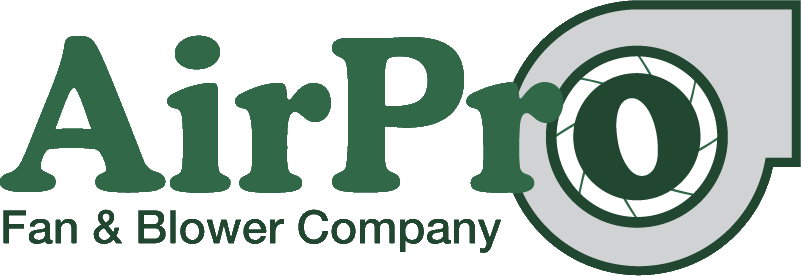
Air Pollution Control Fans
AirPro // Applications
Industrial Air Pollution Control Applications
Industrial processes, especially those that employ combustion at any stage, naturally produce air pollutants as byproducts. Addressing those pollutants safely and efficiently through various industrial air pollution control applications is critical to protecting people and the environment. There are also stringent emissions regulations issued and governed by the United States Environmental Protection Agency’s Clean Air Act. Failure to comply carries steep penalties.
The two main categories of air pollutants industrial processors must address are volatile organic compounds (VOCs) and hazardous air pollutants (HAPs), which can be corrosive and cause great harm to humans, not to mention the planet.
What does all of this have to do with industrial fans and blowers? As it turns out – a lot! From intake to exhaust and virtually everything in between, fans (usually more than one) are at the heart of what makes the industrial air pollution control process work.
Your industrial air pollution control requirements will vary based on local regulations, airstream composition, and size/scale of the operation. All of these variables will influence your air pollution control solution and process fan specifications.
Primary Industries for Air Pollution Control Applications
Pollution control applications are necessary for any industry that produces Volatile Organic Compounds (VOCs) or Hazardous Air Pollutants (HAPs) like flue gas as byproducts of their operations.
Defining VOCs
According to the US EPA, “Volatile organic compounds are compounds that have a high vapor pressure and low water solubility. Many VOCs are human-made chemicals that are used and produced in the manufacture of paints, pharmaceuticals, and refrigerants. VOCs typically are industrial solvents, such as trichloroethylene; fuel oxygenates, such as methyl tert-butyl ether (MTBE); or by-products produced by chlorination in water treatment, such as chloroform. VOCs are often components of petroleum fuels, hydraulic fluids, paint thinners, and dry cleaning agents. VOCs are common ground-water contaminants.”
Defining HAPs
The EPA defines HAPs, “also known as toxic air pollutants or air toxics,” as those pollutants that are known or suspected to cause cancer or other serious health effects, such as reproductive effects or birth defects, or adverse environmental effects. Examples of the 187 listed toxic air pollutants include benzene, methylene chloride, dioxin, asbestos, mercury, and lead compounds.
The EPA regulates emissions and pollution control across a wide swath of industries, including (click on industry to link to the specific regulations related to that industry’s operations):
- Agriculture, Food and Forestry
- Chemical Production and Distribution
- Electric Utilities
- Energy Engines and Combustion
- Foam, Fiber, Plastic and Rubber Products
- Metals Production
- Mineral Processing
- Oil and Natural Gas
- Petroleum Refineries and Distribution
- Semiconductor Manufacturing
- Solvent Use and Surface Coating
- Sterilizers
- Waste Management Industry
Industrial Air Pollution Control Applications and Solutions
There are a number of industrial air pollution control solutions and related applications for air pollution control. We’ve gone into detail to describe the ones we serve most often with our centrifugal fans and blowers:
Selective Catalytic Reduction
Selective Catalytic Reduction (SCR) systems convert harmful nitrogen oxides into safe diatomic nitrogen and water using a variety of catalysts.
Thermal Oxidizers
Oxidizers provide air pollution control through source reduction, turning the hazardous bypass gasses into water vapor through combustion.
Scrubbers
Scrubbers remove or neutralize toxic gasses in the airstream.
Dilution Air
Dilution Air systems reduce the concentration of contaminate in plant emissions by injecting fresh air into the airstream before exhausting it.
Combustion
Combustion produces Nitrogen Oxide (NOx) as a byproduct, which can be reduced through flue Gas Recirculation (FGR) from the boiler exhaust duct back into the combustion chamber.
Pollution Control Fan Technology Selection & Specification
There are a variety of environments across the range of industrial air pollution control application solutions. Some may call for high-temperature fans, others need to be highly corrosion-resistant. They may need to be highly efficient, no-snag, high-pressure, leak-tight, shrouded, or open. The best way to determine the right fan for your application is to speak with an application engineer, who can guide you through the specification and design process.
Fan Designs Commonly Used for Industrial Air Pollution Control Systems
- Backward Curved (BCHS)
- Industrial Exhauster Air Handling (IEAH)
- Backward Inclined (BIHS)
- Radial Tipped (RTHS)
Fan Arrangements, Accessories & Design
All of the fan arrangements and accessories could be viable options for one or more pollution control applications. There are just two things that we virtually always recommend: Vibration and Temperature Sensors along with proper installation and maintenance. Beyond that, the design is application- and environment-specific.
When it comes to pollution control systems, what is for certain is that getting the design right – the first time – is absolutely critical. If the performance is off or something goes wrong with the fan, there’s a lot at stake when health, safety, time, and money are involved. Select a fan you can trust, with guaranteed reliability and a company that stands behind its work.
Talk with Our Application Engineers
If you feel overwhelmed by all this information, don’t despair! We have a team of application engineers who are happy to talk with you and select the best fan for your application. You can call 715-365-3267, email fans@airprofan.com, or send us your information, and one of our engineers will connect with you.
